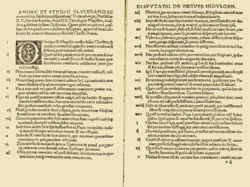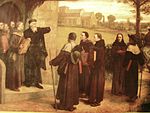Ratramnus
| Part of a series on the |
| Reformation |
|---|
 |
| Protestantism |
Ratramnus (died c. 868)[1] was a Frankish monk of the monastery of Corbie, near Amiens in northern France, and a Carolingian theologian known best for his writings on the Eucharist and predestination. His Eucharistic treatise De corpore et sanguine Domini (On the Body and Blood of the Lord) was a counterpoint to his abbot Paschasius Radbertus’s realist Eucharistic theology. Ratramnus was also known for his defense of the monk Gottschalk, whose theology of double predestination was the center of much controversy in 9th-century France and Germany. In his own time, Ratramnus was perhaps best known for his Against the Objections of the Greeks who Slandered the Roman Church, a response to the Photian schism and defense of the filioque addition to the Niceno-Constantinopolitan Creed.[2] The writings of Ratramnus influenced the Protestant reformation of the 16th century.[3]
Biography
[edit]Little is known of Ratramnus’ life, but some have suggested that he became the teaching master at the Benedictine monastery of Corbie in 844, when Paschasius Radbertus was made abbot.[4] Additionally, he appears to have had a reasonably close relationship with King Charles the Bald.[5]
The Eucharist
[edit]Sometime around 831-833, Paschasius Radbertus, in his role as a teacher in the monastery at Corbie, wrote De corpore et sanguine Domini (Concerning the Body and Blood of the Lord), articulating the view that in the moment of consecration, the bread and wine on the altar became identical with the body and blood of Jesus Christ.[6] Paschasius was clear that the body and blood on the altar are precisely the same natural body and blood as Christ’s incarnate body on earth. In his description of the Eucharist, Paschasius drew a distinction between figura (figure) and veritas (truth), which he understood to mean “outward appearance” and “what faith teaches”, respectively.[7] No controversy seems to have arisen as a result of Paschasius’s treatise, which he first composed likely as a teaching aid and dedicated to one of his former students. Later, probably in 844, Paschasius also composed a revision of his book on the Eucharist, dedicated to Charles the Bald.[8]
When Charles the Bald visited Corbie in 843, he apparently met Ratramnus and requested an explanation of the Eucharist. It was to the emperor, then, that Ratramnus addressed his work, also entitled De corpore et sanguine Domini. In this book, Ratramnus advocated a spiritual view in which the bread and the wine of the Eucharist represent Christ’s body and blood figuratively and serve as a remembrance of him, but are not truly (perceptible by the senses) Christ’s body and blood.[9] Ratramnus used the same two terms (figura and veritas) to describe the Eucharist as Paschasius, but used them differently. For him, veritas meant “perceptible to the senses”, so the Eucharist could not truly be Christ’s body and blood, as it – according to the senses – did not change in appearance, but remained bread and wine, nor was it literally Christ’s historical incarnate body.[10]
No condemnations were issued as a result of the debate, and neither of the two monks quoted or referred to the other in his work.[11] On account of this, Willemien Otten has challenged the traditional interpretation of Paschasius's and Ratramnus’s different positions as a “controversy”.[12]
Predestination
[edit]In the 840s and 50s, Ratramnus became involved in the controversy over the teachings of Gottschalk of Orbais (ca. 803-68). Ratramnus probably first encountered Gottschalk during the wandering teacher’s stay at the monastery of Corbie around 830, and later supported him in his conflict with archbishop Hincmar of Rheims.[13] Gottschalk taught a form of double predestination, teaching that God predestined the fates of both the elect and the damned.
In 851, John Scotus Eriugena was commissioned to oppose Gottschalk’s teaching, but his work, Treatise on Divine Predestination, essentially denied any form of predestination whatsoever, a denial which raised the ire of Ratramnus and Florus of Lyon.[14] In response, Ratramnus composed the two-book work On the Predestination of God (De Praedestinatione Dei),[15] in which he defended double predestination, while objecting to the relation of predestination to sin.[16]
Filioque
[edit]Late in Ratramnus’ life, he responded to the Photian schism of 863-7 between Eastern and Western Christianity over the appointment of Photius as Patriarch of Constantinople. This wide-ranging controversy spanned various East-West disagreements, such as the appointment of the patriarch, ecclesiastical jurisdiction in Bulgaria, and the Western addition of filioque to the Niceno-Constantinopolitan Creed. Ratramnus’ defense of Western theology and practice in his Against the Objections of the Greeks who Slandered the Roman Church,[17] is largely occupied with proving the filioque, although the final section of the work deals with other disagreements, such as the monastic tonsure and priestly celibacy.[18]
Other works
[edit]In another show of support for Gottschalk, Ratramnus composed a short collection of patristic texts in favor of Gottschalk’s Trinitarian formulation of trina deitas[19] against Hincmar of Rheims’ proposed summa deitas.[20]
Ratramnus also wrote a Letter on the Dog-headed Creatures.[21] This was in response to a question from Rimbert, then working as a missionary in Scandinavia, who asked whether the cynocephali believed to live nearby were human, because if they were Rimbert would be expected to attempt to convert them. Ratramnus argued that because Rimbert’s sources described the cynocephali as living in villages and engaging in agriculture and crafts, they must be rational and therefore human.[22]
Ratramnus wrote another treatise, The Birth of Christ,[23] possibly as a response to Paschasius’ De Partu Virginis.[24] In this work, Ratramnus defended the idea that Christ’s birth from the Virgin Mary occurred in the natural human way, so as to not detract from Christ’s real human nature.[25]
Ratramnus wrote two treatises on the soul, upholding traditional Augustinian psychology.[26] The first, On the Soul, was written against someone named Macarius Scotus,[27] and the second, The Book on the Soul, addressed to bishop Odo I of Beauvais, challenged an idea raised by an anonymous monk of Fly Abbey – that all human beings participate in a universal soul. In The Book on the Soul, Ratramnus argued that a soul cannot be universal, only individual.[28]
On a whole, Ratramnus’ works have been described by medieval scholar Giulio D'Onofrio as marked by a careful methodological clarity and consistency possibly modeled on Boethius’ Answer to Eutyches.[29]
Later reception
[edit]At some point, Ratramnus’ Eucharistic work De corpore et sanguine Domini came to be identified as the work of John Scotus Eriugena. In the 11th century, Berengar of Tours seized upon “Scotus’” book as a source for his view of the Eucharist in his debate with Lanfranc of Bec, and was summarily condemned by the local Council of Vercelli in 1050. Around 1100, further confusion arose when Ratramnus’ name was mistakenly copied in some works as Bertramus, a mistake which endured even into the 19th century.[30]
In the 16th century, Ratramnus’ work once more became the center of controversy. After De corpore et sanguine Domini was printed in 1531, Protestant reformers seized upon the book as a counterpoint to the Catholic doctrine of transubstantiation. It was especially influential in England, where Thomas Cranmer claimed to have been finally convinced against transubstantiation by Ratramnus.
See also
[edit]References
[edit]Citations
- ^ Ratramnus, Corbiensis Deutsche Nationalbibliothek
- ^ G.E. McCracken, ed. Early Medieval Theology, Library of Christian Classics 9 (Louisville: KY, 1957), pp. 109-47, here 109.
- ^ "Ratramnus | Benedictine theologian | Britannica". www.britannica.com. Retrieved 2021-11-21.
- ^ James Ginther, Westminster Handbook to Medieval Theology, (Louisville, KY: Westminster John Knox Press, 2009), 155-6.
- ^ McCracken, Early Medieval Theology, 109.
- ^ Willemien Otten, "Between Augustinian sign and Carolingian reality: the presence of Ambrose and Augustine in the Eucharistic debate between Paschasius Radbertus and Ratramnus of Corbie," Nederlands archief voor kerkgeschiedenis 80, no. 2 (2000): 137-156, here 140.
- ^ McCracken, Early Medieval Theology, 92.
- ^ Patricia McCormick Zirkel, "The Ninth-Century Eucharistic Controversy: A Context for the Beginnings of Eucharistic Doctrine in the West," Worship 68, no. 1 (1994): 2-23, here 5.
- ^ Otten, "Between Augustinian sign and Carolingian reality," 140.
- ^ McCracken, Early Medieval Theology, 111.
- ^ McCracken, Early Medieval Theology, 110-11.
- ^ Otten, "Between Augustinian sign and Carolingian reality," 143.
- ^ Ginther, Westminster Handbook to Medieval Theology, 75.
- ^ Ginther, Westminster Handbook to Medieval Theology, 153.
- ^ J.P. Migne, ed. Patrologia Latina 121:11-80
- ^ McCracken, Early Medieval Theology, 109.
- ^ PL 121:223-346.
- ^ McCracken, Early Medieval Theology, 109-10.
- ^ Giulio D’Onofrio, ed., History of Theology II: The Middle Ages (Collegeville, MN: Liturgical Press, 2008), 80.
- ^ McCracken, Early Medieval Theology, 110.
- ^ Ratramnus, Epist. de cynocephalis ad Rimbertum presbyterum scripta, PL 121:1153-6; Dutton, "Ratramnus and the Dog-headed Humans"
- ^ McCracken, Early Medieval Theology, 110; Steel, How to Make a Human, 145-50
- ^ PL 121:81-102
- ^ McCracken, Early Medieval Theology, 109.
- ^ D’Onofrio, History of Theology II: The Middle Ages, 80.
- ^ Ginther, Westminster Handbook, 156.
- ^ A. Wilmart, “L’opuscule inedité de Ratramne sur la nature de l’âme” Revue Bénédictine 43 (1931): 207-223.
- ^ D’Onofrio, History of Theology II: The Middle Ages, 81.
- ^ D’Onofrio, History of Theology II: The Middle Ages, 79.
- ^ McCracken, Early Medieval Theology, 112-13.
Sources
- Chazelle, C. “Exegesis in the Ninth-Century Eucharistic Controversy.” In The Study of the Bible in the Carolingian Era. Ed. C. Chazelle and B. van Name Edwards. pp. 167–87. Turnhout: Brepols, 2003.
- Chazelle, C. “The Eucharist in Early Medieval Europe,” in A Companion to the Eucharist in the Middle Ages, ed. Ian Levy, Gary Macy, and Kristen Van Ausdall. Leiden: Brill, 2011, pp. 205–49.
- Dutton, Paul Edward, ed. and trans. "Ratramnus and the Dog-Headed Humans." In Carolingian Civilization: A Reader. 2nd Ed. Readings in Medieval Civilization and Cultures 1. pp. 452–55. Ontario: Broadview Press, 2004.
- Fahey, John J. “The Eucharistic Teaching of Ratramnus of Corbie.” Unpublished PhD diss. (St. Mary of the Lake Seminary, 1951).
- Ginther, James. Westminster Handbook to Medieval Theology, Louisville, KY: Westminster John Knox Press, 2009.
- McCracken, G.E., ed. Early Medieval Theology, Library of Christian Classics, vol. 9. Louisville: KY, 1957.
- Otten, Willemien. "Between Augustinian sign and Carolingian reality: the presence of Ambrose and Augustine in the Eucharistic debate between Paschasius Radbertus and Ratramnus of Corbie." Nederlands archief voor kerkgeschiedenis 80, no. 2 (2000): 137-156.
- Phelan, Owen M. "Horizontal and Vertical Theologies: "Sacraments" in the Works of Paschasius Radbertus and Ratramnus of Corbie" Harvard Theological Review 103:3 (2010) 271-289.
- Ratramnus, De corpore et sanguine Domini: texte original et notice bibliographique, ed. J. N. Bakhuizen Van Den Brink, 2nd ed. Amsterdam and London: North-Holland, 1974.
- Roberts, Timothy Roland. “A translation and critical edition of Ratramnus of Corbie's De Predestinatione dei. Unpublished PhD diss. (University of Missouri, Columbia, 1977).
- Steel, Karl. How to Make a Human: Animals and Violence in the Middle Ages, Columbia: Ohio State University Press, 2011.
- Tanghe, W.V. “Ratramnus of Corbie’s Use of the Fathers in his Treatise De corpore et sanguine Domini.” Studia Patristica 17, no. 1 (1982): 176-80.
- Zirkel, Patricia McCormick. "The Ninth-Century Eucharistic Controversy: A Context for the Beginnings of Eucharistic Doctrine in the West." Worship 68, no. 1 (1994): 2-23.
External links
[edit]- The Body And Blood Of The Lord by Ratramnus in English translation.
- . New International Encyclopedia. 1905.
- . Encyclopædia Britannica (11th ed.). 1911.
- . Catholic Encyclopedia. 1913.

